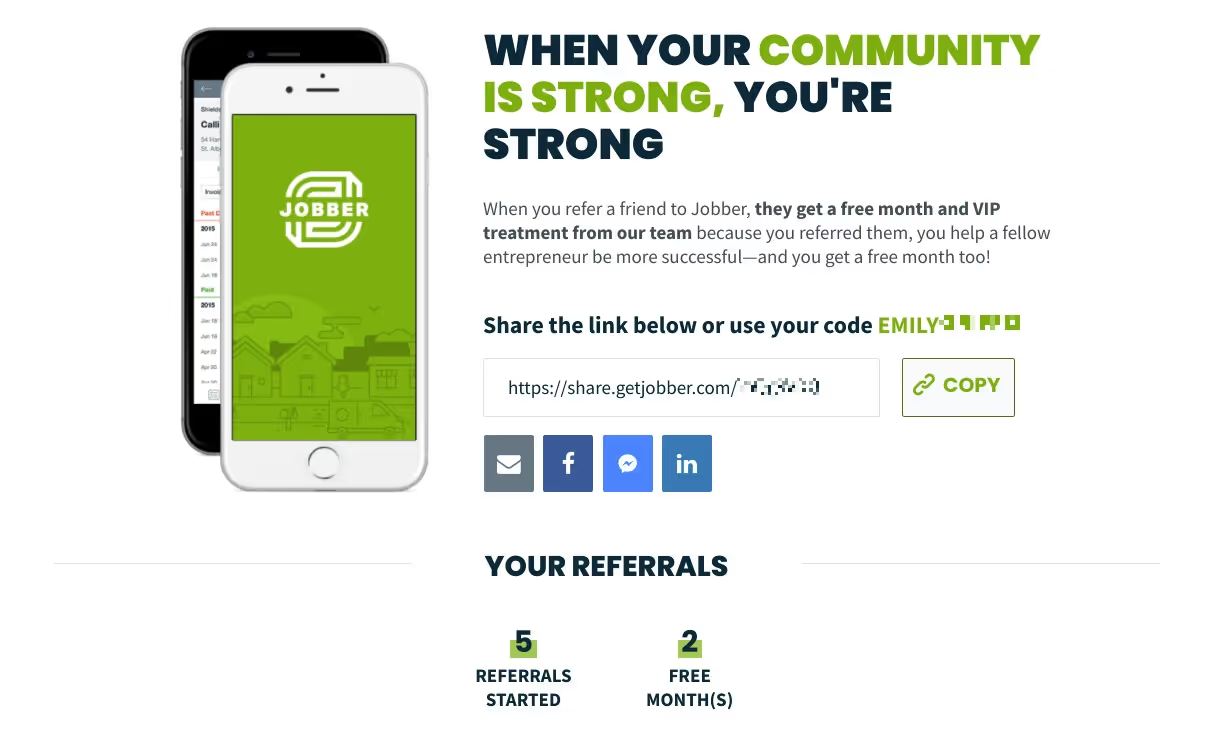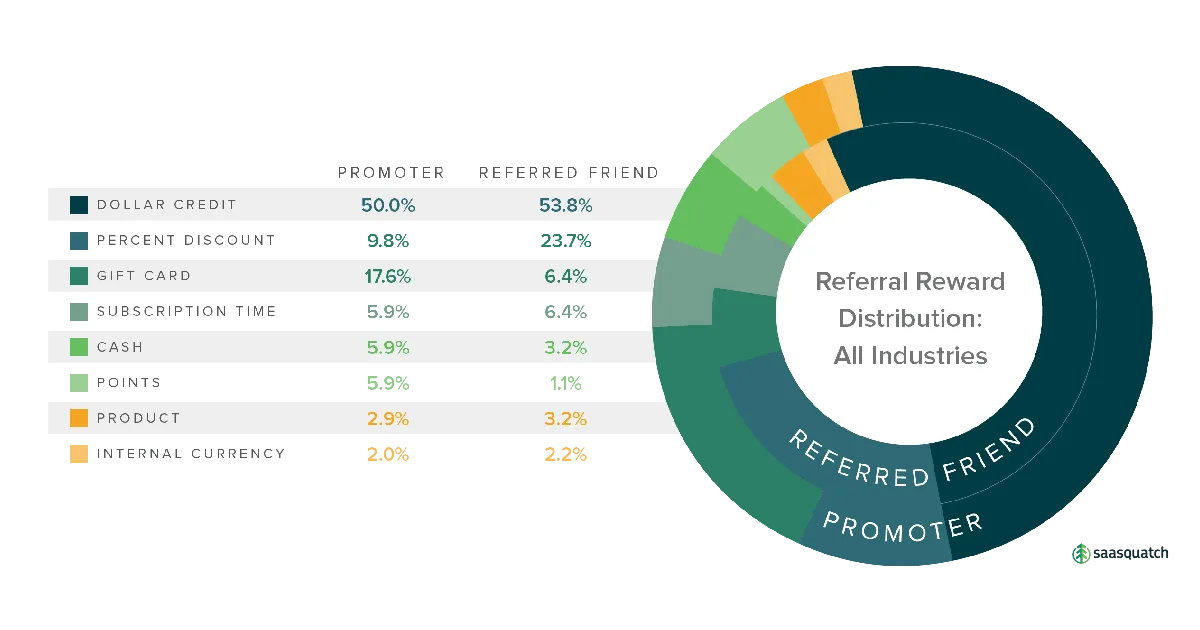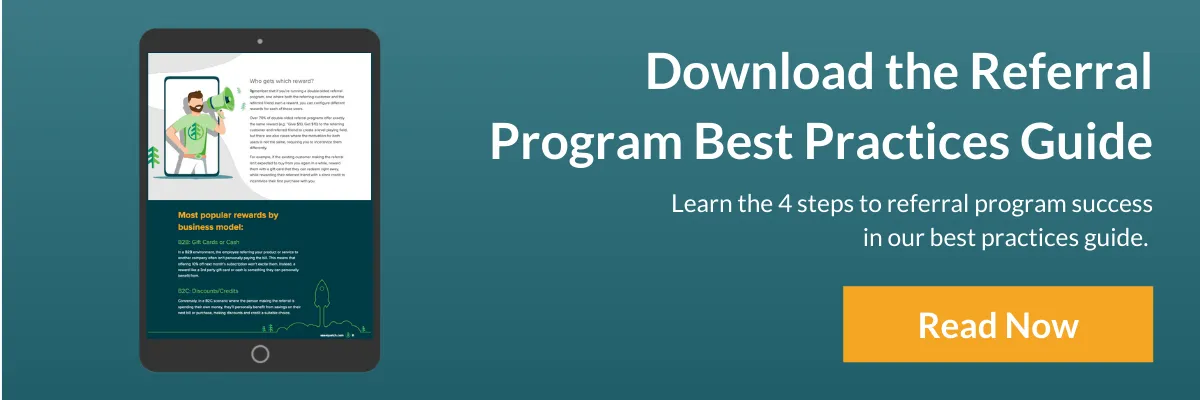4 Steps to Referral Program Success: Best Practices Guide
Whether you’re launching your very first referral program or re-visiting this powerful marketing channel, we’ve analyzed the key characteristics of our top-performing programs and outlined them in this guide to help with best practices.
At SaaSquatch, we’ve launched referral and loyalty programs for hundreds of companies around the world. We’re excited to share our years of expertise so you get the best results as soon as possible.
Here are the steps you need to get started:
- Make your program visible and accessible
- Choose a reward that motivates your customers to refer
- Give out rewards when a referral is successful
- Promote your program through multiple channels
Step 1: Engage your customers
Possibly the most critical parts of your referral program are having users find it and engage with it. The most successful programs are always highly visible to your users and have a low friction flow to take users through the referral journey.
Program Placement
The more frequently your customers see the referral program the more likely they are to participate. Don’t be shy and think you need to hide your program! A well-designed referral program is a welcomed feature by your customers.
The best-performing programs are accessible on every screen of your app. In fact, we’ve seen program performance more than double simply by making it more visible.
This starts with placing the referral program behind your customer account/member login or wherever your customers spend most of their time. Whenever possible, we recommend integrating the program into your web or mobile app so that you eliminate any additional login credentials for your customers to remember.
If this isn’t an option, using a dedicated platform like SaaSquatch means you can instead leverage a hosted portal that is fully brandable. Referring customers can log in to view the status of their referrals and rewards.

The most common way for your users to engage with your referral program should be through a “referral widget”. With SaaSquatch, this can be a hosted widget placed within your brand’s ecosystem using SSO or a natively built user experience powered by SaaSquatch's APIs. This widget can be a pop-out, full-page, or embedded.
For brands who leverage SaaSquatch, we have a marketer-friendly editor accessible right from your dashboard, or we can build pixel-perfect custom themes if you choose to work with our in-house design team. Custom widgets create an even more seamless experience for your users when every component is perfectly aligned with your existing branding.
Either way, the referral widget is your users’ one-stop-shop for everything referral-related. It should display their referral codes/links, social buttons for quick sharing, and their referral history and stats. In other words, when customers can easily access the referral widget, you have a better chance of referrals being initiated
Tip: Focus on making your referral widget highly visible within your app and don’t expect users to go looking for it.
When placing this widget behind your member login, it’s good to have it in an easily accessible place such as the navigation menu, the user/customer dashboard or the footer of every screen:

A platform like SaaSquatch also lets you leverage an API to get the referral data out from SaaSquatch and plug it into your own native dashboards for a fully custom experience. This gives you full control over the information you present to your users and helps drive the motivation needed for increased referrals.
Users have come to expect a fully-embedded experience and won’t be as willing to participate in your program when they need to navigate elsewhere, especially when using your mobile app.
Program Flow
This is an important step because it’s often the referred friend’s first interaction with your company, and you need to make it easy for them to accept the referral. When one of your existing customers shares their referral link with a friend, you can decide what kind of experience the referred friend has when they click on it.
Typically, clicking on a referral link takes the user to a dedicated landing page that acknowledges they have been referred and lets them know:
- Who invited them (e.g. “Your friend Alex invited you to try [company name]”)
- What reward they will earn (e.g. “You’ll receive a 25% discount on your first 3 months as a subscriber”)
- What they need to do to earn it (e.g. “Click here to subscribe”)
The best landing pages leverage details about the referring user like their name and photo to personalize the experience.
By making it easy to accept and move forward with the referral, you keep the user engaged and increase your chances of acquiring a new customer. If the referred friend gets stuck or confused after clicking a referral link, you will struggle to maximize conversions.
Step 2: Find a suitable reward
To incentivize customer referrals, it’s important to find a reward that doesn’t break your budget but still motivates your customers and partners to invite their networks. Commonly-used rewards include:
- Credit
- Discounts
- Gift Cards
- Points
- Cash
- Custom Rewards (swag, gifts)
Here’s a quick breakdown of who typically uses what reward types and when:
| Reward: | Used by Brands Like: | Often Seen In: | Works Well When: |
| Dollar Credit | Uber, Airbnb, Rothy’s, TaskRabbit, Skip the Dishes, Flytographer | E-Commerce, On-Demand Apps, Marketplaces
B2C |
|
| Percent Discount | Society6, SmugMug, Typeform, MeUndies, Fiverr | E-Commerce, On-Demand Apps, Subscription Services B2C |
|
| Cash | Tangerine, Payoneer, Rakuten, Leesa | Financial products/services
B2B |
|
| Gift Cards | T-Mobile, Sprint, Endy, Casper, Habito, 23andMe | Large-value B2C purchases
B2B |
|
| Points | Evernote, Samsung, Care/of, Canva | B2C |
|
Who gets which reward?
Remember that if you’re running a double-sided referral program, one where both the referring customer and the referred friend earn a reward, you can configure different rewards for each of these users.
Over 70% of double-sided referral programs offer exactly the same reward (e.g. “Give $10, Get $10") to the referring customer and referred friend to create a level playing field. However, there are also cases where the motivation for both users is not the same, requiring you to incentivize them differently.
For example, if the existing customer making the referral isn’t expected to buy from you again in a while, reward them with a gift card that they can redeem right away, while rewarding their referred friend with a store credit to incentivize their first purchase with you.
Most popular rewards by business model:
B2B: Gift Cards or Cash
In a B2B environment, the employee referring your product or service to another company often isn’t personally paying the bill. This means that offering 10% off next month’s subscription won’t excite them. Instead, a reward like a 3rd party gift card or cash is something they can personally benefit from.
B2C: Discounts/Credits
Conversely, in a B2C scenario where the person making the referral is spending their own money, they’ll personally benefit from savings on their next bill or purchase, making discounts and credit a suitable choice.
Most popular rewards overall:

* Data based on an independent analysis of 102 referral programs.
What is the “best” reward?
Finding the best reward for your program is a combination of understanding industry trends, what’s relevant to your users, what your company can offer, and what motivates your customers.
We know that there is no one-size-fits-all reward, which is why SaaSquatch works with you to help answer each of these questions and develop a plan that fits your brand. By using industry data, case studies and details about your business and customers we can dramatically lower the learning curve and time to success.
Remember that your primary objective should be to launch your program so you can start learning how customers respond to your offer, and then test and optimize as needed. Quite often your program will go through iterations as you find the best unit and amount of rewards to offer for optimal engagement.
Additional Resources:
- Guide to Referral Program Rewards
- When, Why and How to use Gift Cards as Referral Rewards
- B2B Referral and Loyalty Rewards
Step 3: Choose when to reward customers
Generally speaking, the goal of a referral program is to get your existing customers to encourage a new user to engage with your product or service for the first time. But before you give out a reward to thank the customer who referred them, you want to make sure that this new user is actually engaging with your product.
In other words, you need to make sure that your company has benefited, or very likely will benefit, from the new customer before you give out rewards. To do this, decide what kind of action or criteria the referred friend must accomplish/meet in order to classify a referral as “successful”.
We refer to this as the “conversion event” to signify a successful referral.
Some examples of referral conversion events are when:
- The referred user makes a first purchase (can set minimum purchase amounts)
- The referred user becomes a paying subscriber (or upgrades from a freemium trial)
- The referred user links certain items to their account (e.g. links a credit card for auto-pay)
- The referred user fills out certain information in their profile
Choosing your referral program’s conversion event is your chance to select what action by the referred friend is most valuable for initiating a long-term business relationship with them. You want to select an event that indicates the new user is engaged with your product or service, and on their way to becoming a long-term customer.
For many transaction-based businesses, rewards are given out when the referred friend makes a purchase. This makes sense because it indicates that this new user is trying out your brand and you now have the opportunity to nurture them into a highly-profitable, loyal customer.
On the other hand, in a subscription-based environment, a custom event may be more valuable for the referred friend to complete to earn their reward. A custom event is any user action or criteria that you can track within your application. Having the user fill out their profile, pre-load money into the app, or log a certain number of hours, are a few examples of custom events that can help drive the necessary product adoption required for a recurring commitment to your product/service.
For example, Dropbox considers a referral successful when the referred friend has installed the app on their computer. They believe this action makes the user more likely to continue engaging with the product.
You can even combine purchases and custom events to create a one-of-a-kind referral program that rewards promoters differently for various actions that the referred friend completes:

Above all, choosing your conversion event requires a balance between what you’re asking customers to do and what you’re rewarding them with once they do it.
For example, if you’re only issuing rewards when the referred friend spends $200 but an average transaction is only $20, you will see very few conversions. But if you make the criteria too easy, such as issuing rewards when the referred friend signs up for a free trial, you may open your program up to fraud and have a hard time achieving a positive return on investment.
If you have a refund/trial period when customers make a purchase, you want to make sure that rewards are sent after this period has passed. Otherwise, this will be another avenue for fraudsters to take advantage of your program’s rewards.

Step 4: Promote your Program
Believing your referral program will promote itself is a common misconception. Airbnb actually cites a lack of promotion as one of their early referral program’s biggest problems – not even their employees knew it existed.
This makes marketing your referral program a key to its success. If no one knows about it, no one will use it. The SaaSquatch team will work with you to outline marketing initiatives, but some of the most common practices are:
- Placing it in-app on as many pages and screens as logical
- Sending an email announcement to your existing contacts announcing the new program and where to access it
- Adding prominent links to the program on your website and within your app
- Creating an explainer page on your website to house all program details
- Including a blurb on the invoices sent to your customers (ex. “You could get this at a $25 discount next time if you make a successful referral”)
- Having your customer support team promote the program after positive interactions with clients
- Posting on social media channels
- Adding a link to the program in your team’s email signatures:

When it comes to the right time to promote your program, think of when your customers are most likely to feel positively towards your brand. Positive emotions increase a user’s likeliness to further engage with your product or service. For example:
- For a mobile budgeting app, this moment could be once the user has stayed within their monthly spending goals.
- If you provide a CRM tool, this might be when a user closes a sale using your software or has collected a certain number of leads.
- If you run a monthly subscription box, this could be after the customer has had their 3rd consecutive box delivered, clearly indicating satisfaction with their purchase.
With fresh, positive feelings towards the use of your product or service, a customer is much more likely to want to refer a friend or try one of your new features if presented with the opportunity.
Identify the places in your application or website where a user would be feeling the most positive, and remind them about your loyalty incentives, either through in-app messaging or an email notification.
Download the referral program best practices guide below so you don't miss a step, or talk to us to learn more.
